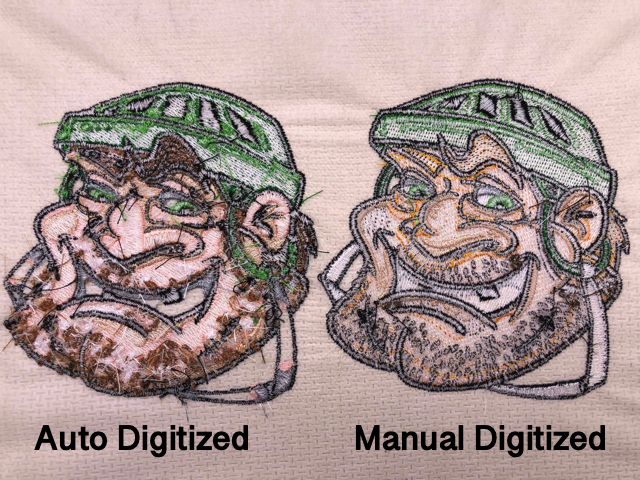Explore Various Kinds of Embroidery Digitizing Techniques
Needlework digitizing has progressed substantially over the years, supplying a myriad of techniques to bring layouts to life in the electronic world. The realm prolongs to more advanced strategies like photorealistic embroidery digitizing and the fascinating world of 3D embroidery digitizing.
Standard Hand Needlework Digitizing
Standard hand needlework digitizing includes the process of transforming detailed hand-stitched layouts into electronic layouts for equipment embroidery. This strategy needs skilled artisans to carefully examine the handmade style and after that make use of specialized software to recreate it in an electronic format. Each stitch, color, and detail must be meticulously equated to make sure that the essence of the initial hand needlework is protected in the digital version.
Among the key difficulties of typical hand embroidery digitizing is recording the details and subtleties of the handmade style. Digitizing for Embroidery. Artisans should have a deep understanding of various embroidery strategies, such as satin stitch, chain stitch, and French knots, to precisely replicate these strategies in the electronic realm. In addition, they need to have an eager eye for detail to ensure that the digital style maintains the exact same degree of artistry and workmanship as the original hand-stitched piece
Punching Strategy
To seamlessly transition from typical hand embroidery digitizing to the boxing method, artisans should currently concentrate on converting the detailed electronic layouts right into instructions that needlework makers can analyze. The boxing method involves using specialized software application to produce electronic documents which contain commands for the embroidery device to comply with. This procedure calls for a deep understanding of not simply the style itself however also the capacities and restrictions of the embroidery device.

Auto-Digitizing Software Application Programs
Needlework digitizing has been reinvented by the advent of auto-digitizing software application programs, providing craftsmens with innovative devices to convert electronic layouts into needlework device instructions effectively. Auto-digitizing software application make use of algorithms to assess electronic images or vector files and produce embroidery layouts automatically. These programs enable quick and exact conversion of detailed designs right into stitch patterns, conserving time and effort for embroiderers.
One of the essential advantages of auto-digitizing software is its user-friendly interface, making it obtainable to both novices and experienced digitizers. These programs frequently include functions such as stitch editing devices, thread color matching, and the capability to preview the last anonymous embroidered layout. Additionally, auto-digitizing software program can deal with complex designs with several shades and elaborate details, producing high-quality needlework data appropriate for numerous apparel and textile jobs.
While auto-digitizing software provides benefit and effectiveness, it is vital for customers to comprehend the constraints of automated digitizing. Fine-tuning More hints and manual adjustments might still be needed to achieve the wanted needlework high quality, specifically when dealing with detailed or unique styles. By leveraging the capacities of auto-digitizing software application together with manual digitizing methods, artisans can enhance their needlework digitizing procedure and develop magnificent stitched pieces.
Photorealistic Embroidery Digitizing
Utilizing advanced digital imaging methods, accomplishing photorealistic cause needlework digitizing has actually come to be a desired skill amongst modern craftsmens. This method entails transforming high-resolution images into complex stitch patterns that very closely mimic the initial layout, causing embroidery pieces that show natural detail and deepness.
To attain photorealistic needlework digitizing, artisans must possess an eager eye for detail and a complete understanding of just how different stitch kinds and thickness can impact the final end result. By thoroughly drawing up each shade and color in the picture, embroiderers can develop a digital documents that guides the needlework device to duplicate the nuances of the original picture precisely.
Photorealistic embroidery digitizing is especially popular in developing personalized styles for garments, home decoration, and art items where recording the significance of a picture or art work is crucial. This method permits craftsmens to change memories, landscapes, portraits, and intricate art work right into sensational embroidered work of arts that showcase a blend of traditional workmanship and innovative modern technology.
3D Needlework Digitizing
With the development of digital imaging techniques in attaining photorealistic results in embroidery digitizing, the exploration of 'D Needlework Digitizing' provides a brand-new dimension to the intricacies of design replication. 'D Embroidery Digitizing' describes the three-dimensional digitizing method that includes depth and texture to needlework styles, producing an extra realistic and aesthetically appealing final item. This technique makes use of software that imitates get redirected here the effect of light and shadow on the needlework layout, boosting its general visual influence.
Among the key advantages of 'D Embroidery Digitizing' is its capacity to make layouts look more lifelike and dynamic. By including deepness to the needlework layout, the end product shows up much more realistic and fascinating (Digitizing for Embroidery). In addition, this strategy permits even more innovative flexibility in layout execution, enabling embroiderers to trying out various structures and results that were previously testing to achieve
Verdict
